
Crop rotation is the practice of growing a series of different types of crops in the same area across a sequence of growing seasons. It reduces reliance on one set of nutrients, pest and weed pressure, and the probability of developing resistant pest and weeds.

Panicum virgatum, commonly known as switchgrass, is a perennial warm season bunchgrass native to North America, where it occurs naturally from 55°N latitude in Canada southwards into the United States and Mexico. Switchgrass is one of the dominant species of the central North American tallgrass prairie and can be found in remnant prairies, in native grass pastures, and naturalized along roadsides. It is used primarily for soil conservation, forage production, game cover, as an ornamental grass, in phytoremediation projects, fiber, electricity, heat production, for biosequestration of atmospheric carbon dioxide, and more recently as a biomass crop for ethanol and butanol.

Agroforestry is a land use management system in which trees or shrubs are grown around or among crops or pastureland. This diversification of the farming system initiates an agroecological succession, like that in natural ecosystems, and so starts a chain of events that enhance the functionality and sustainability of the farming system. Trees also produce a wide range of useful and marketable products from fruits/nuts, medicines, wood products, etc. This intentional combination of agriculture and forestry has multiple benefits, such as greatly enhanced yields from staple food crops, enhanced farmer livelihoods from income generation, increased biodiversity, improved soil structure and health, reduced erosion, and carbon sequestration. Agroforestry practices are highly beneficial in the tropics, especially in subsistence smallholdings in sub-Saharan Africa and have been found to be beneficial in Europe and the United States.

Pennisetum is a widespread genus of plants in the grass family, native to tropical and warm temperate regions of the world. They are known commonly as fountaingrasses

Miscanthus, or silvergrass, is a genus of African, Eurasian, and Pacific Island plants in the grass family.

Worldwide more human beings gain their livelihood from agriculture than any other endeavor; the majority are self-employed subsistence farmers living in the tropics. While growing food for local consumption is the core of tropical agriculture, cash crops are also included in the definition.
Push–pull technology is a strategy for controlling agricultural pests by using repellent "push" plants and trap "pull" plants. For example, cereal crops like maize or sorghum are often infested by stem borers. Grasses planted around the perimeter of the crop attract and trap the pests, whereas other plants, like Desmodium, planted between the rows of maize, repel the pests and control the parasitic plant Striga. Push–pull technology was developed at the International Centre of Insect Physiology and Ecology (ICIPE) in Kenya in collaboration with Rothamsted Research, UK. and national partners. Research and development for the push-pull strategy was funded by a number of partners including the Gatsby Charitable Foundation of the UK, the Rockefeller Foundation, the UK’s Department for International Development, and the Global Environment Facility of the UNEP, among others. Additionally, research conducted jointly by the International Centre of Insect Physiology and Ecology and Rothamsted Research helped to identify effective companion plants to be used with this strategy and provided empirical evidence of the efficacy of push-pull pest management technology. This technology has further been taught to smallholder farmers through collaborations with universities, NGOs and national research organizations.

Energy crops are low-cost and low-maintenance crops grown solely for energy production by combustion. The crops are processed into solid, liquid or gaseous fuels, such as pellets, bioethanol or biogas. The fuels are burned to generate electrical power or heat.
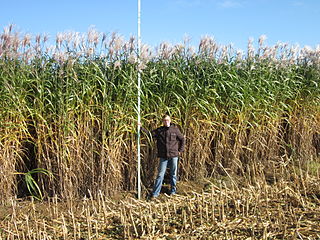
Miscanthus × giganteus, the giant miscanthus, is a sterile hybrid of Miscanthus sinensis and Miscanthus sacchariflorus. It is a perennial grass with bamboo-like stems that can grow to heights of more than 4 metres (13 ft) in one season. Just like Pennisetum purpureum, Arundo donax and Saccharum ravennae, it is also called elephant grass.
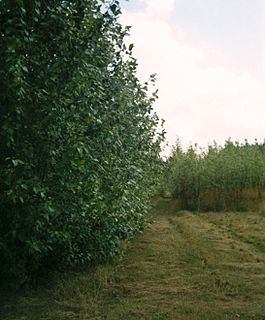
Short rotation coppice (SRC) is coppice grown as an energy crop. This woody solid biomass can be used in applications such as district heating, electric power generating stations, alone or in combination with other fuels. Currently, the leading countries in area planted for energy generation are Sweden and the UK.
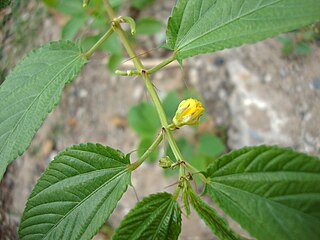
Jute mallow or nalta jute is a species of shrub in the family Malvaceae. Together with C. capsularis it is the primary source of jute fiber. The leaves and young fruits are used as a vegetable, the dried leaves are used for tea and as a soup thickener, and the seeds are edible.

Commercial sorghum is the cultivation and commercial exploitation of species of grasses within the genus Sorghum. These plants are used for grain, fibre and fodder. The plants are cultivated in warmer climates worldwide. Commercial Sorghum species are native to tropical and subtropical regions of Africa and Asia.

Agricultural sustainability in northern Nigeria requires flexibility in both ecological management as well as economic activity. Rainfall occurs only seasonally – and there is a pronounced dry season – however, rainfall is often intensive when it does come, making it necessary for farmers to employ soil moisture conservation techniques. The main crops grown in the region are millet, sorghum, and cowpea, while groundnut and sesame are significant minor crops. Wild foods also serve as an important supplement to the diet, especially during times of food shortage. The bulk of crops are grown during the rainy season which begins in June or July, when temperatures are warmer. There has traditionally been a division between sedentary farmers made up of the Manga and Hausa people, and the nomadic pastoralists known as Fulani, however this has diminished in recent times. Historically, development plans for this region have focused on the use of imported technology and irrigation schemes, while neglecting traditional farming practices of the region. These traditional practices generally focus on the close integration between the raising of livestock and farming, and have been studied in detail in the Kano Close Settled Zone of Northern Nigeria.

Busseola fusca is a species of moth that is also known as the maize stalk borer. It is known from Ethiopia.
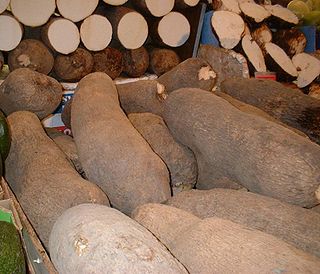
Nigeria is by far the world’s largest producer of yams, accounting for over 70–76 percent of the world production. According to the Food and Agriculture Organization report, in 1985, Nigeria produced 18.3 million tonnes of yam from 1.5 million hectares, representing 73.8 percent of total yam production in Africa. According to 2008 figures, yam production in Nigeria has nearly doubled since 1985, with Nigeria producing 35.017 million metric tonnes with value equivalent of US$5.654 billion. In perspective, the world's second and third largest producers of yams, Côte d'Ivoire and Ghana, only produced 6.9 and 4.8 million tonnes of yams in 2008 respectively. According to the International Institute of Tropical Agriculture, Nigeria accounted for about 70 percent of the world production amounting to 17 million tonnes from land area 2,837,000 hectares under yam cultivation.

Cassava production is vital to the economy of Nigeria as the country is the world's largest producer of the commodity. The crop is produced in 24 of the country's 36 states. In 1999, Nigeria produced 33 million tonnes, while a decade later, it produced approximately 45 million tonnes, which is almost 19% of production in the world. The average yield per hectare is 10.6 tonnes.
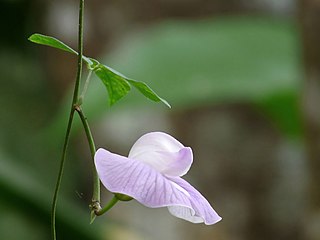
Centrosema pubescens, common name centro or butterfly pea, is a legume in the family Fabaceae, subfamily Faboideae, and tribe Phaseolae. It is native to Central and South America and cultivated in other tropical areas as a forage for livestock.
Chilo partellus, the spotted stalk borer, is a moth in the family Crambidae. It was described by Charles Swinhoe in 1885. It is found in India, Pakistan, Ethiopia, Lesotho, Madagascar, Malawi, South Africa, Sudan, Tanzania, Uganda and on Mayotte.
Sorghum is an important staple crop for more than 500 million people in sub-Saharan Africa and South Asia, including many people in Nepal. In statistics collected from 1992-1994 about general millet, Nepal had an area of 0.21 million ha, with a yield rate of 1.14 (t/ha), and produced around 0.24 million tons of sorghum. The entirety of the crop is highly valued, with both the grain and the stem being utilized. The Terai region of Nepal tends to be more tropical which is ideal for the growth of sorghum. It tolerates hot climates better than maize or soybeans. For subsistence farmers, like those in Nepal, fertilizers are not necessary and the crop is frequently harvested by hand.
Chintala Venkat Reddy is an innovative organic farmer known for his soil and nutrient management techniques in farming. He holds the distinction of being the first independent farmer in India to receive an international patent for his technique in soil swapping and soil fertility.

















